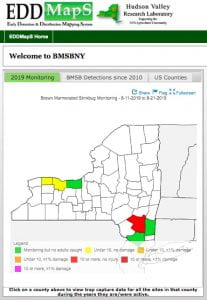
Synopsis:
Newly emerging adults have been laying eggs over the past few weeks. This week we’ve been observing 1st and 2nd instar of Brown Marmorated Stink Bug (BMSB) Halyomorpha halys (Stål) at the HVRL in Highland, NY. Newly emerged BMSB adults in outdoor cages with Habanero and Jalapeño pepper also show signs of 2nd generation with newly lain eggs and nymphs emerging. The 1st instar nymphs can be seen feeding on beneficial egg symbionts essential for BMSB development, all of which point to the development of a 2nd generation and increasing BMSB numbers.
Traps have begun to exceed threshold at the HVRL. However, we are seeing only very low levels of BMSB in commercial mid-Hudson Valley orchard sites to date.
That said, monitoring your BMSB traps & scouting should precede management during this time of BMSB population build-up. When thresholds or stink bug become visible along the orchard edge, border row applications should begin. These should then be followed by alternate row then whole orchard applications as movement of native and BMSB populations begin to migrate into orchards. As stink bug are orchard edge opportunists, the majority of the injury to fruit will occur along the 30′ perimeter edge. Insecticides selected for whole orchard applications should also have strong efficacy for apple maggot, obliquebanded leafroller, and as we move into September, codling moth for which management may be required.
Insecticide tools with various degrees of efficacy for BMSB management.
Overview:
The brown marmorated and native green stink bug are arboreal insects, residing in woodland habitat. However, when populations continue to rise through July into August, increasing numbers of adults and nymphs can be observed on tree fruit. his has occurred over the past two weeks. Increasing presence of the insects in trees will result in injury in peach, pear and apple rows bordering woodlands and hedgerows. Nymphs ranging from 2nd to 5th instar of both species have been observed feeding on fruit along the orchard perimeter this week.
This newly developing partial second generation will significantly increase BMSB population in woodlands. As host quality from the arborial woodland habitat declines, increasing migration to tree fruit is very likely through the end of August on through to the end of October. Increased scouting should be based on recent and upcoming Tedders trap captures. This will be especially important if weather turns dry with irrigated tree fruit becoming a favored host of BMSB as adults begin to feed more intensively as they prepare for their overwintering phase.

Video of this trap with threshold numbers of BMSB.
Remember that trap captures combined with scouting for the various life stages of the insect along the orchard perimeter rows should be the basis for insecticide applications. Unlike most other pests, we should not be using IPM thresholds based on stink bug feeding that results in fruit damage. As expression of the injury occurs 7-10 days or longer after feeding, you would have missed your opportunity to reduced injury if you postpone preventative applications while waiting on injury that has already occurred to become visible.

Use a conservative presence and trap threshold on through harvest. Finding a single BMSB or green stink bug in the tree canopy within 100′ of scouted perimeter row would be considered a conservative threshold. Driving along the orchard will likely spook the insects. You’ll need to stealth your way quietly around the orchard…its good exercise in the early evening or morning. Green stink bug tend to remain low while BMSB tend to move to the tops of the trees to feed.
When selecting insecticides for border row, alternate row and whole orchard applications you should consider constraints on your markets. If weather turns to drought, then longer residue based on the active ingredient minimum residue level (MRL) could become an issue, especially in EU markets and Israel. Review your options carefully with regards to harvest dates, PHI’s, re-application intervals and seasonal A.I. volume.
When BMSB populations dramatically increase during late season, migration into orchards can be dramatic. BMSB have been known to funnel down to the last variety standing (such as the high value Pink Lady). In which case applications in late October may be warranted!!
Applications of insecticides selected for whole orchard applications should also have strong efficacy for apple maggot and obliquebanded leafroller, which also require management this week.
One of the most effective tools for use to manage BMSB is the active ingredient bifenthrin in a number of formulations.
Bifenthrin has a 12 hr. re-entry interval, 14 day pre-harvest interval and a 30 day re-application interval.
We received notice that the EPA has approved the Section 18 application for bifenthrin for use against the brown marmorated stink bug for 2019. Links below provide access to PDF copies of the Section 18 labels for materials containing the A.I. bifenthrin.
Labels should be made available to the applicator during bifenthrin applications. These can be printed or available as digital files such as PDF’s on tablets or smart phones. The exemption is valid through October 15th 2019 as a “Section 18 EXEMPTION under FIFRA, FOR DISTRIBUTION AND USE ONLY IN Columbia, Dutchess, Orange, Ulster, Monroe, Orleans, Wayne and Niagara Counties this year. Use in any other counties is prohibited in NEW YORK STATE”.
For all Bifenthrin products, the Section 18 permit can be used in apple, peach and nectarine. Do not apply more than a total of 0.50 lbs ai/acre per season. Apply as necessary to maintain control using a minimum of 30‐day spray intervals, 14-day pre-harvest interval and a 12 hour REI. Bifenthrin labels include:
Bifenture 10DF Insecticide/Miticide (EPA Reg. No. 70506‐227)
Bifenture®EC Agricultural Insecticide (EPA Reg.No.70506‐57)
Brigade WSB (EPA REG. NO. 279-3108)




